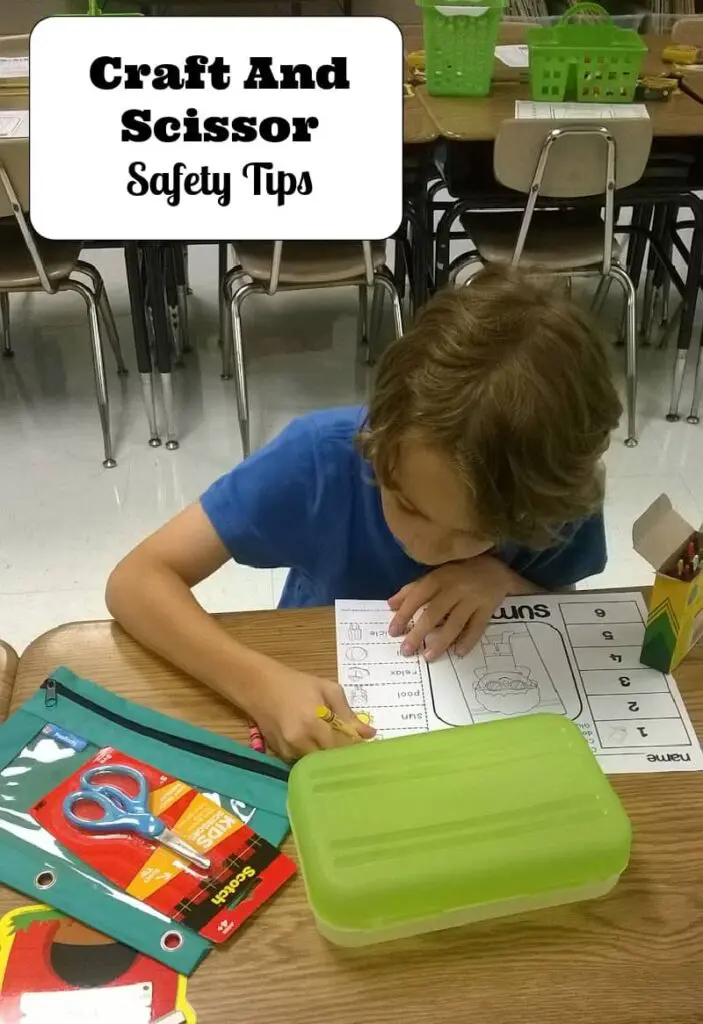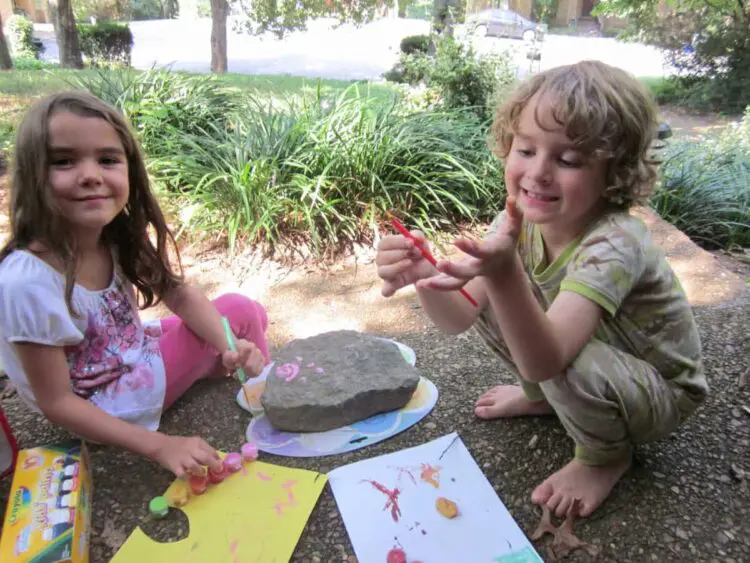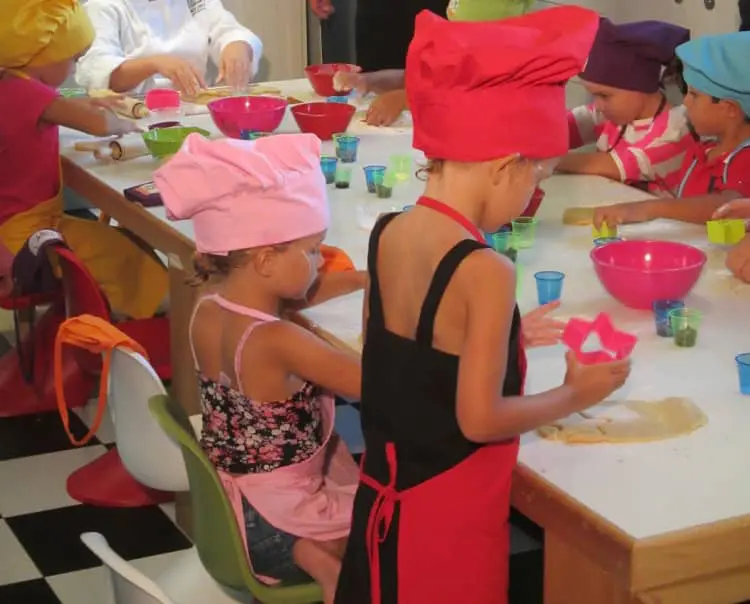One of the many areas where we can do our part to keep kids safe is right at home. As a do-it-yourself enthusiast, I know just how much fun a craft project can be for a little one. However, I’m also aware of the risks that can accompany crafts for kids if you’re not careful. Today, I want to share my top craft and scissor safety tips to keep your DIY crafting kids accident-free! Here are safety tips to keep in mind with doing preschool crafts with your little ones at home or in the classroom.

Scissor And Craft Safety Tips For Preschoolers And Kindergartens
Here are general craft safety tips tailored for young children to help keep craft time fun and accident-free. I will start with scissors since they are high up on the things to be careful with list.
1. Safety Scissors
Purchase child safety scissors with blunt edges and teach children how they’re used properly. Even though this style of scissor will help avoid accidents, they’re not risk-free. Make sure kids know to handle scissors -only when properly seated and to keep fingers away from the blades.
- Supervise young children – Watch closely while they’re learning to use scissors.
- Use age-appropriate scissors – Children should use blunt-tip or safety scissors.
- Teach proper grip – Thumb in one handle, fingers in the other, with the thumb on top.
- Always cut away from your body – Never point the blades toward yourself or others.
- Keep fingers away from the blades – Use the handles properly to avoid injury.
- Hold scissors by the closed blades when passing them – Pass them handle-first to others.
- Store safely – Keep scissors in a secure place when not in use, preferably in a closed container.
- Stay seated while cutting – Especially important for children to reduce the risk of accidents.
- Use for cutting only – Don’t use scissors to pry, poke, or unscrew things.
2. Supervision
Be cautious and never leave kids unattended. Young children should be always be supervised when using craft supplies. Demonstrate first before letting kids try a new technique or material.

3. Non-Toxic Art And Craft Supplies
Use only non-toxic paints, glues and markers. While we may use permanent markers as adults, we don’t think about drawing all over ourselves like kids sometimes do! While we may safely use things like super glue as adults, kids may get it all over their hands! Using super glue without getting any on their fingers can be challenging even for older kids. If this should happen, here are some tips for glue removal from skin.
4. Remove Choking Hazards
Be careful with small parts. Buttons, plastic beads, and other fun small embellishments are really appealing to curious and hungry toddlers. Make sure to keep them on you and away from tiny fingers. You don’t want them to become a choking hazard. Glitter can be dangerous to toddlers if they inhale it or put it in their mouths so don’t use in glitter in crafts with young children. Kids should be at least 5 and have supervision before using these materials.
5. Prepare A Work Space
Create a DIY space just for kids. Keep this area clear of any tools or materials you don’t want them to have access to. It’s also a good idea to keep this low to the ground to avoid accidental falls. You may want to protect the work space with a layer of newspapers for easy cleanup.
6. Limit use of heated materials.
Some craft projects may require a little help from a hairdryer, a glue gun or other heat involving tools. Instead of allowing the children to use these on their own, let them assist you whenever possible. When not in use, be sure to keep these out of reach from little hands.
7. Avoid Sharp Edges
Always keep an eye out for sharp edges. If it can cause more than a paper cut, think twice before allowing kids to use it.

8. Wear protective clothing.
When necessary, dress children in long sleeves, pants and shoes to avoid skin exposure. This comes in handy when they are doing messy paint projects. They may like to wear an apron when making with things like play dough.
9. Wash Hands
Teach preschoolers to always wash their hands when they are done with a craft. This is a good practice to make sure there are no supplies stuck to their skin. As much as young children tend to touch their noses and everything else, it is also just good for sanitary reasons to prevent the spread of germs.
10. First Aid Kit
Keep a first aid kit handy and have emergency numbers on the kit, just in case. I used to look after a little preschooler who had a thing for Band-Aids. You could find them in every room of the house, in various shapes, sizes and colors. To him, those flimsy little Band-Aids were the ultimate protection against danger and I never took the time to explain the difference to him, because all that mattered was that he felt safe.
When it comes to kids, it is always better to be safe than sorry. I hope these crafting safety tips help you out when doing preschool crafts! Last but not least, HAVE FUN! What is your favorite project that your crafting kids have done?
Related Posts:

Lana says
Craft time can be so much fun, but it’s easy to overlook some of the safety details—especially with younger kids. I really appreciate the tips on using age-appropriate tools and keeping things non-toxic. And the glitter safety advice? Spot on! Definitely bookmarking this for our next art day. Thanks for sharing!
Edna says
This is such an important reminder! It’s easy to assume kids know how to use scissors safely, but teaching proper handling—like passing them handle-first and always cutting away from the body—makes a huge difference. I also love the tip about sitting while cutting. Definitely sharing this with a few fellow parents. Thanks for the practical advice!
Sydney says
I like to use glitter glue or pre-mixed glitter paint – less messy and safer for crafts.
Eric Menk says
This is such an important safety reminder! It’s easy to assume kids know how to use scissors safely, but teaching proper handling—like passing them with the blades shut and always cutting away from the body— makes a huge difference.